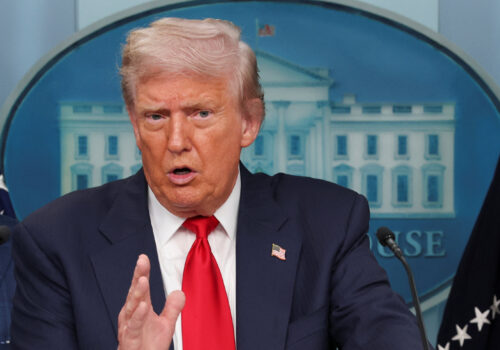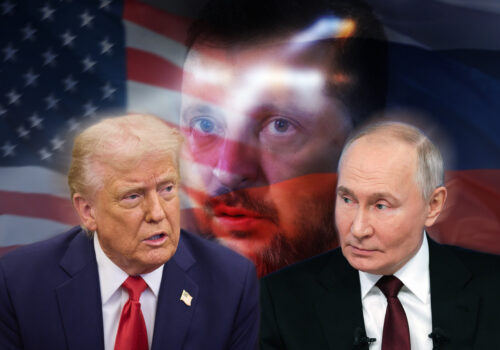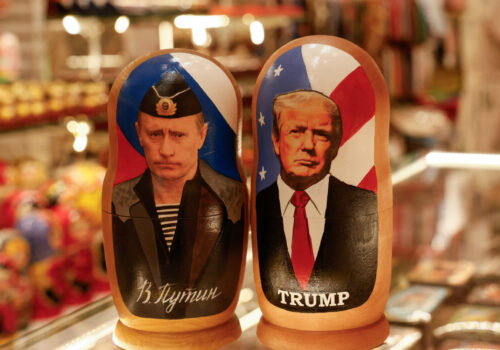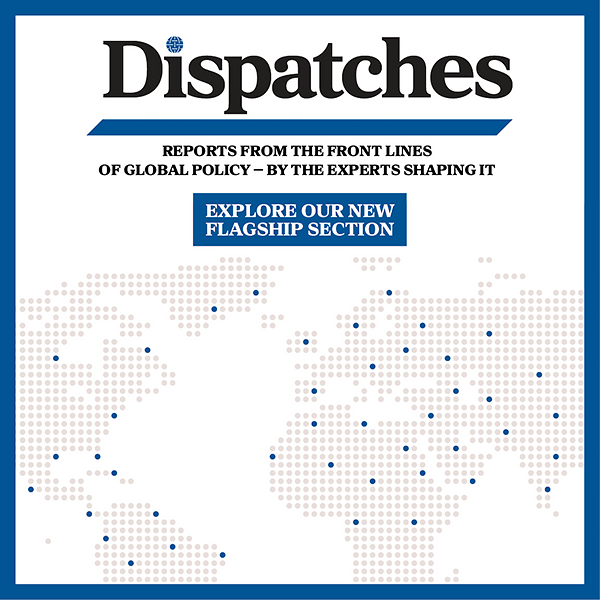“We didn’t get there.” This was the verdict US President Donald Trump delivered after a nearly three-hour meeting with Russian President Vladimir Putin in Alaska on Friday. It was the first face-to-face meeting between Russian and US heads of state since the start of Putin’s full-scale invasion of Ukraine in February 2022. Trump had trekked to Alaska hoping to set in motion a cease-fire in Russia’s war. Putin got away with not even agreeing on a pause. Indeed, Russian forces attacked Ukraine during the meeting. Both presidents raised the possibility of another meeting—perhaps in Moscow—but made no firm commitments. So, what’s next for Ukraine and for Trump’s peace-seeking process? Below, Atlantic Council experts share their insights on what came out of Alaska.
Click to jump to an expert analysis:
Daniel Fried: No deal, no cease-fire, and not much sign of progress
Oleh Shamshur: Putin was intransigent on the most important issue of the talks
Philippe Dickinson: Putin’s tactic is to stall and stall some more
Edward Verona: Don’t be fooled by Putin’s talk of US-Russia business prospects
Melinda Haring: Trump should remember that the United States holds the cards, not Russia
Brian Whitmore: Russia’s goals remain maximalist and eliminationist
If Putin offered no real concessions, then Trump’s response should be quick and comprehensive
Putin will be returning to Moscow with a smile on his face. For the second time in two weeks, Putin achieved his tactical objective of avoiding “severe consequences” from the United States for his refusal to end the shooting in Ukraine. Trump had set a hard deadline of August 8 for Putin to accept a ceasefire. But playing off Putin’s meeting with Special Envoy Steve Witkoff on August 6, Trump pushed for a meeting instead, and the deadline lapsed.
In recent days, Trump promised major steps against Russia if Putin did not indicate a willingness to make peace in Alaska. While both Putin and Trump referred to a positive meeting, Trump noted that they had not “gotten there” on the big issue—peace in Ukraine—although he added that he was optimistic they would reach that goal. It is notable that Trump said he would get on the phone quickly with NATO leaders and Ukrainian President Volodymyr Zelenskyy, while Putin hoped that those leaders would not “throw a wrench” into this nascent diplomatic process. Putin is anticipating that the Europeans will be underwhelmed by Trump’s report and will try, as they did before this summit meeting, to persuade him to take a stronger position.
At this point, there are few details on the meeting. What precisely did Putin offer that prompted Trump to speak positively of the meeting? It is likely that some details will leak out after Trump briefs Zelenskyy and NATO. That will put us in a position to judge whether Putin, finally, has offered some steps forward. If so, maybe a summit with Zelenskyy would be merited. But before that, Trump should send a private message to Putin to stop the bombardment of Ukrainian cities and civilians—or face new sanctions. And if it turns out that Putin offered no concessions in Anchorage, very quick and comprehensive steps are needed: massive sanctions on Russia and the dispatch of a major US arms package, paid for by Europe, to Ukraine.
—John E. Herbst is the senior director of the Atlantic Council’s Eurasia Center and a former US ambassador to Ukraine.
Trump wants the killing to stop—and he’s put his own political capital on the line to try
It appears the talks were positive but, unfortunately, not conclusive. This isn’t too surprising—the White House said before the meeting this was a preliminary step. Trump did say in a Fox News interview after the meeting that there would be a follow-up meeting between Putin and Zelenskyy. If that happens, it would be an incredibly positive step forward. Importantly, Trump sounded hopeful, which is a good sign.
Trump has made it clear there will be severe consequences if Putin walks away from the negotiations. It looks like he is willing to give him a little bit of leeway in the hopes that peace talks will move forward. But if Putin tries to jerk him around and slow roll progress, I would expect those severe consequences to kick in very quickly.
The underlying problem that makes this so difficult is that the Biden administration slow-rolled the weapons Ukraine needed to win for two and a half years. This created a perfect environment for Putin’s forces to entrench themselves inside Ukraine. That has given Putin a battlefield advantage—emboldening him and giving him leverage.
Whatever comes of this, I commend Trump for his efforts. He wants peace and wants the killing to stop—and he is willing to put his own political capital on the line and roll up his sleeves and try.
—Leslie Shedd is a nonresident fellow at the Atlantic Council’s Eurasia Center and the president of Rising Communications.
No deal, no cease-fire, and not much sign of progress
It could have been worse. Trump and Putin could have made a dirty deal at Ukraine’s expense—surrendering Ukrainian land to Russia, for example—and Trump could have tried to pressure Zelenskyy into accepting it. Instead, there was no deal, no cease-fire, and not much sign of progress in ending Russia’s war against Ukraine. (During his press statement, Trump referred vaguely to having made some progress, but unless later administration readouts show more detail, skepticism is in order.)
Trump raced to this meeting on the assumption, mistaken it appears, that Putin was ready to make progress in ending the war on Ukraine on terms other than Ukraine’s surrender. That was based on Witkoff’s August 6 meeting with Putin in Moscow. When that appeared wrong, due either to Witkoff’s misunderstanding or Putin’s deception, Trump started speaking again of putting pressure on Russia. Trump even remarked to the press while flying to Anchorage that pressure would come if there were no progress, including a cease-fire. But faced with what appears to be Putin’s stonewalling, lectures on history, or other dodges, Trump backed away again.
Therefore, advantage Putin: He got a meeting and slipped away without offering anything other than bromides about US-Russian friendship. Trump could respond to being stiffed by Putin. He could do what he threatened and agree, at last, to put pressure on Russia’s economy, especially its revenue from oil sales. There are viable options for doing so. Trump could make clear that the United States will work with Europe to back Ukraine, including with more weapons. Here too, there are viable options for doing so without crossing Trump’s line of no direct US assistance—for example, lend lease arrangements.
Trump risks looking weak and may, and hopefully will, respond by pushing Putin to end the war. In that case, Putin’s arrogance could yet prove the Russian leader’s downfall. But that’s merely a hope. Unless evidence emerges to the contrary, the Trump administration has let its advantages sit idle while an aggressive adversary gets away with taunting the United States.
—Daniel Fried is the Weiser Family distinguished fellow at the Atlantic Council and a former US ambassador to Poland.
Putin was intransigent on the most important issue of the talks
The meeting looks like a win for Putin. There was high ceremony and a warm reception (painful for Ukrainians to watch), a breaking out of diplomatic isolation, and a delaying again of a round of harsher direct and secondary sanctions. There was, in other words, quite a bit to sell his new “victory” to the Russian public and to an international audience of both friends and foes.
As might have been expected, Putin was intransigent on the most important issue of the talks—Russia’s war in Ukraine. He was cynical and hypocritical (even speaking of security for Ukraine) in his remarks, and at the same time not flinching from his usual justification of the war and his intention to carry on with aggression. The summit did not prevent Putin from hitting scores of civilian targets in Ukraine and continuing his summer offensive.
It is still unclear what will happen after the meeting.
The answer depends on knowing what the “many points of agreement” are that Trump was referring to during the briefing. Was it window dressing on his part, or did he and Putin really find common ground on some relevant issues? Will we hear from Trump anytime soon even muted criticism of Putin, or see “severe consequences” for the absence of a cease-fire deal he was craving for?
For the time being, Trump was ostensibly relishing in Putin’s flattery and did not seem to relinquish his desire of dealing with the Russian dictator as a valued partner, including by realizing business opportunities Putin talked about and revamping bilateral relations.
—Oleh Shamshur is a nonresident senior fellow at the Atlantic Council’s Eurasia Center and a former Ukrainian ambassador to the United States.
Putin’s tactic is to stall and stall some more
This was the treading water summit. At least, that’s as much as we can glean from the short press conference with no media questions, and a curtailed bilateral agenda. With little seemingly achieved, this was nobody’s worst-case scenario. There will be sighs of relief in Kyiv and European capitals that the feared Munich 1938–style capitulation didn’t materialize.
For Putin, he got to share the stage with the president of the United States and proffer enough flattery and meaningless talk of respecting Ukrainian security to stave off further immediate sanctions and economic pressure. In the context, his reference to good neighborliness was a window into the limitlessness of his cynicism. The stalling and the stringing-this-out allows Putin to continue to throw human beings into the meat grinder, and eke out more Ukrainian territory, inch by inch. He will consider that a win.
So, what next for the United States and its allies? It’s an insight so blindingly obvious it hardly counts as such, but Putin will only respond to strength and pressure. Now is the time for the Europeans to press on Trump that Putin is the only obstacle to peace, and that Trump should finally apply his “peace through strength” approach to this conflict: to dial up the collective military, diplomatic, and economic pressure on Russia, both directly and indirectly through the countries that continue to enable Putin’s war machine. Absent that, Putin will continue to happily tread water in the bloody lake he has created.
—Philippe Dickinson is a deputy director with the Transatlantic Security Initiative at the Atlantic Council’s Scowcroft Center for Strategy and Security. Prior to joining the Council, he was a career diplomat with the United Kingdom’s Foreign, Commonwealth and Development Office.
Don’t be fooled by Putin’s talk of US-Russia business prospects
Putin was keen to achieve an outcome from the Anchorage summit that he could cast as a victory for Russia. The optimal result for him would have been the acceptance by his US counterpart of Russia’s demand for territorial concessions by Ukraine. True to his training as a KGB operative, Putin likely calculated that he could appeal to Trump’s predilection for announcing business deals by bringing along some key economic and business figures in his entourage.
Undoubtedly to Putin’s disappointment, and fortunately for Ukraine, it seems that the bait failed to attract the quarry. “There’s no deal until there’s a deal,” Trump stated during the press conference, which might have applied as much to business prospects as to a broader peace agreement. However, it is hard to imagine that, had some slapdash investment framework been announced, any serious US companies would be tempted back to Russia. Even if US sanctions were softened, European sanctions would remain in effect, posing legal and financial risks in the world’s largest trading block. The reputational harm of doing business in a country committing war crimes would be unacceptable. Moreover, nothing has changed in Russia itself. Corruption is endemic and foreign companies would be at the mercy of a rapacious business elite that would have little to fear from going after American companies once evanescent goodwill from a summit meeting evaporates.
—Edward Verona is a nonresident senior fellow at the Atlantic Council’s Eurasia Center covering Russia, Ukraine, and Eastern Europe.
Trump should remember that the United States holds the cards, not Russia
There was nothing but fool’s gold to be found in Anchorage. Good on Trump for trying to bring peace to Ukraine, but diplomacy is slow and boring and requires more than performative public relations stunts held at the last minute with little planning. Let’s hope that Trump sees through Putin’s endless appetite to talk and tires of the Russian dictator’s pseudo-historical lectures. Trump can squeeze the Russians; he seems to forget that the United States holds the cards, not Moscow. The most telling statement came from Putin, who said the root causes behind the war remain the same. This means that Putin’s position is unchanged. To him, Ukrainians aren’t real people, the Ukrainian language is fake, and he’s still intent on destroying a sovereign and democratic nation that deserves US sympathy and support.
—Melinda Haring is nonresident senior fellow at the Atlantic Council’s Eurasia Center.
Russia’s goals remain maximalist and eliminationist
The Alaska summit did not change the fundamentals of Russia’s war against Ukraine. Russia’s goals remain maximalist and eliminationist. This was evident in Putin’s repeated calls to address the “root causes” of the war, a euphemism for Ukraine existing as a fully sovereign state free of Russian domination. This is not surprising. Putin’s goals in Ukraine have always been ideological, and there is simply no grand bargain that will satisfy him shy of Ukraine’s total capitulation, which will not happen. This war will be decided on the battlefield. And the most effective way to assure that it ends on the battlefield sooner rather than later and in Ukraine’s favor is for the United States and its allies to continue arming Ukraine. In addition, they can increase economic pressure on Russia through the secondary sanctions included in legislation sponsored by US senators Lindsey Graham and Richard Blumenthal.
The only clear winner, at least in the short term, was Putin, who saw his international isolation ended. Putin did not get the sanctions relief he sought, and he seems to have fallen short of decoupling Ukraine from normalizing economic relations with the United States. But he got the optics of a red-carpet welcome from the US president on US soil without making a single concession.
—Brian Whitmore is a nonresident senior fellow with the Eurasia Center, an assistant professor of practice at the University of Texas-Arlington, and host of The Power Vertical Podcast.
Further reading
Thu, Aug 14, 2025
When he meets Putin in Alaska, ‘heterodox’ Trump will face his biggest geopolitical test yet
Inflection Points By Frederick Kempe
The outcome of the meeting in Anchorage could have a long-lasting impact on geopolitics, Trump’s legacy, and his Nobel Peace Prize aspirations.
Mon, Aug 11, 2025
Alaska Summit: Trump must press Putin over future Ukrainian security
UkraineAlert By John E. Herbst
Trump-Putin Alaska Summit: If Moscow insists on the acceptance of Russian control over Ukrainian land for a ceasefire, it must accept strong measures to bolster Ukrainian security as well, writes John E. Herbst.
Thu, Aug 14, 2025
Alaska Summit: Trump wants a real estate deal. Putin wants an empire.
UkraineAlert By Peter Dickinson
US President Donald Trump appears to view peace negotiations with Vladimir Putin as a geopolitical real estate deal. But the Russian dictator is not fighting for land in Ukraine. He is fighting for Ukraine itself, writes Peter Dickinson.
Image: US President Donald Trump and Russian President Vladimir Putin look at each other during a press conference following their meeting to negotiate an end to the war in Ukraine, at Joint Base Elmendorf-Richardson, in Anchorage, Alaska, U.S., August 15, 2025. REUTERS/Kevin Lamarque




